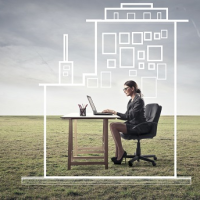February 13, 2015
New report highlights the borderless and liquid nature of the diverse workplace
 Predicting the office the future is not an exact science, but sometimes a report comes along which does a decent job of cutting through the fog and pointing us in the right direction. The Kinnarps’ Trend Report 2015, published this week by the firm’s future labs workshops, draws out some important themes for the new diverse workplace; the borderless and liquid nature of modern working life, how co-working clusters are now a mature trend, why designers need to consider the introvert as well as the collaborative extrovert worker; wellness as the new sustainability and the fact that people will and should be allowed, to modify the environment in which they work. Five key trends were identified in the report, the impact these have on working life are examined and suggestions made on how designers can apply them in their workplace design strategies.
Predicting the office the future is not an exact science, but sometimes a report comes along which does a decent job of cutting through the fog and pointing us in the right direction. The Kinnarps’ Trend Report 2015, published this week by the firm’s future labs workshops, draws out some important themes for the new diverse workplace; the borderless and liquid nature of modern working life, how co-working clusters are now a mature trend, why designers need to consider the introvert as well as the collaborative extrovert worker; wellness as the new sustainability and the fact that people will and should be allowed, to modify the environment in which they work. Five key trends were identified in the report, the impact these have on working life are examined and suggestions made on how designers can apply them in their workplace design strategies.
The report, the result of a 12 month research and consultation programme conducted in collaboration with a panel of key opinion-formers focuses on the impact the current ‘Diverse Decade’, is having on the design of the office, where there are not only greater differences in gender and age, (for the first time four generations of workers occupy the same workspace), but there are also wildly different working styles, forms of employment and mind-sets.
The five trends are described as:
- Designing for diversity, how design meets the needs of the many;
- Office biology, how our work environment is adapting to our minds and bodies;
- ‘Techiture’, how analogue and digital architecture create the new workplace;
- Co-creation in the mass collaboration era; how we collaborate without borders and;
- Micro-multinationals, which describes a workforce in constant flow.
For me, one of the overriding themes of the report is that one size does not fit all, and for every office worker who loves a collaborative workspace there are people who crave silence. Conversely, many of those who work mainly or exclusively from home are feeling so lonely they’re opting to re-enter the workspace at least for part of the time.
The impact of technology is another interesting point. While our buildings now have access to more intelligent data than ever, the modern wireless office, no longer cluttered with acres of cables is being designed to look more like a home office. So it seems that in the future, while we might work from home less, we’ll go to work in an environment that in appearance seems more like home than ever.
To download a copy of the report go to Kinnarps Trend Report 2015.
[embedplusvideo height=”283″ width=”450″ editlink=”https://bit.ly/17BFYEw” standard=”https://www.youtube.com/v/-0j0bSYYXYc?fs=1&vq=hd720″ vars=”ytid=-0j0bSYYXYc&width=450&height=283&start=&stop=&rs=w&hd=1&autoplay=0&react=0&chapters=¬es=” id=”ep1781″ /]













